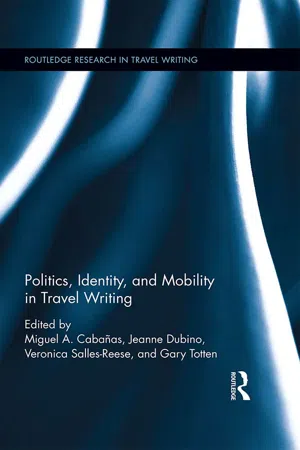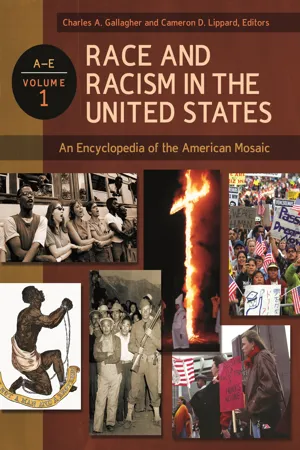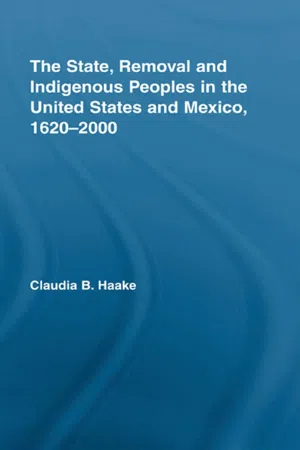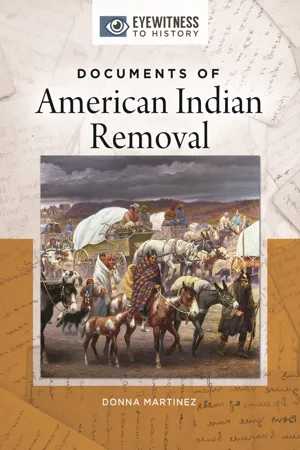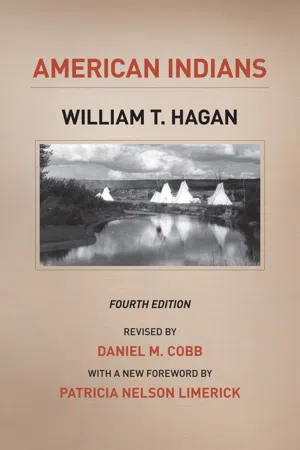History
Indian Removal Act
The Indian Removal Act was a law passed by the United States Congress in 1830, which authorized the removal of Native American tribes from their ancestral lands in the southeastern United States to territories west of the Mississippi River. This forced relocation, known as the Trail of Tears, resulted in the displacement and suffering of thousands of Native Americans, leading to a significant loss of life and cultural heritage.
Written by Perlego with AI-assistance
Related key terms
Related key terms
1 of 4
Related key terms
1 of 3
10 Key excerpts on "Indian Removal Act"
- eBook - ePub
Disasters and Tragic Events
An Encyclopedia of Catastrophes in American History [2 volumes]
- Mitchell Newton-Matza, Mitchell Newton-Matza, Mitchell Newton-Matza(Authors)
- 2014(Publication Date)
- ABC-CLIO(Publisher)
Primary Documents
1. Indian Removal Act of 1830
Signed by President Andrew Jackson, the Indian Removal Act of 1830 forced the removal of the Native American groups to lands west of the Mississippi River. In 1838, the Cherokee Nation suffered the “Trail of Tears.” Not only were the Cherokees forced to an area already occupied, but thousands died along the way.The Indian Removal Act of 1830
CHAP. CXLVIII.—An Act to provide for an exchange of lands with the Indians residing in any of the states or territories, and for their removal west of the river Mississippi.Be it enacted by the Senate and House of Representatives of the United States of America, in Congress assembled, That it shall and may be lawful for the President of the United States to cause so much of any territory belonging to the United States, west of the river Mississippi, not included in any state or organized territory, and to which the Indian title has been extinguished, as he may judge necessary, to be divided into a suitable number of districts, for the reception of such tribes or nations of Indians as may choose to exchange the lands where they now reside, and remove there; and to cause each of said districts to be so described by natural or artificial marks, as to be easily distinguished from every other.SEC. 2. And be it further enacted, That it shall and may be lawful for the President to exchange any or all of such districts, so to be laid off and described, with any tribe or nation within the limits of any of the states or territories, and with which the United States have existing treaties, for the whole or any part or portion of the territory claimed and occupied by such tribe or nation, within the bounds of any one or more of the states or territories, where the land claimed and occupied by the Indians, is owned by the United States, or the United States are bound to the state within which it lies to extinguish the Indian claim thereto.SEC. 3. And be it further enacted, That in the making of any such exchange or exchanges, it shall and may be lawful for the President solemnly to assure the tribe or nation with which the exchange is made, that the United States will forever secure and guaranty to them, and their heirs or successors, the country so exchanged with them; and if they prefer it, that the United States will cause a patent or grant to be made and executed to them for the same: Provided always, That such lands shall revert to the United States, if the Indians become extinct, or abandon the same. - eBook - ePub
All Things Dickinson
An Encyclopedia of Emily Dickinson's World [2 volumes]
- Wendy Martin Ph.D., Wendy Martin Ph.D., Wendy Martin Ph.D.(Authors)
- 2014(Publication Date)
- Greenwood(Publisher)
In addressing the 21st Congress, President Andrew Jackson (1767–1845) announced that, after 30 years, two tribes had accepted the U.S. government’s call for their removal, which would serve as an example for other tribes: “It will place a dense and civilized population in large tracts of country now occupied by a few savage hunters” (“President’s Message,” 1830, 4). The Indian Removal Act of 1830 called for “an exchange of lands with the Indians” living in any U.S. territories and their subsequent removal west of the Mississippi River. The act allowed the president to give Indians certain territories that the United States would “forever secure and guaranty to them, and their heirs and successors.” The act also allowed the president to authorize payment to the Indians for their lands, to exercise authority over the tribes, and to protect the Indians “against all interruption and disturbance . . . from any other person or persons whatever.”In 1835, a small group of Cherokee signed the Treaty of Echota, which agreed to a migration from the current Cherokee land. Cherokee Chief John Ross (1790–1866) protested the treaty; he claimed that those who signed it had no authority to do so. In a letter to the Senate and the House, Ross wrote, “[W]e are despoiled of our possessions . . . . We are stripped of every attribute of freedom and eligibility for legal self-defence . . . . We are denationalized; we are disfranchised” (1836). In 1838 and 1839, the Cherokee nation’s forced relocation under the Indian Removal Act came to be known as the Trail of Tears. After only 2,000 out of 18,000 Cherokee voluntarily migrated, U.S. troops aggressively enforced Jackson’s Act. About 4,000 Cherokee died en route.Native Americans travel through a snowstorm in a forced migration to land set aside by the Indian Removal Act of 1830. (North Wind Picture Archives)Yet, this matter was not simply resolved nor did the tribes quietly cede to the U.S. government’s laws. After the Civil War, the military’s main task “was to cope with the Indians, but other developments” impeded this (Wooster 1988, 13–14). Some whites were found with the tribes; one newspaper account recalled that “Not only are there white refuges with the northern tribes, but there are white men who once held good positions in civilized life, with the Comanches and the Apaches” (“Indians,” 1867, 3). Also, tribes did fight in myriad ways against U.S. forces, and were not simply passive in the face of their removal. The Cherokee nation went to the Supreme Court in order to retain their land and own governance. In The Cherokee Nation v. The State of Georgia - Brian D. McKnight, James S. Humphreys(Authors)
- 2011(Publication Date)
- The Kent State University Press(Publisher)
22But still the argument over Andrew Jackson’s culpability in removal continues. Alfred A. Cave, in “Abuse of Power: Andrew Jackson and the Indian Removal Act of 1830,” makes it clear that the Indian Removal Act of 1830, which Jackson pushed through Congress, stated that Indians would have to agree to removal. Furthermore, the act did not authorize the president to break existing treaties guaranteeing Indians the rights to land in the states where they lived; neither did the act authorize the forced emigration of Indians. But both these things happened because Jackson and his minions resorted to extralegal means to coerce the Natives. Cave goes on to contend that past historians of Indian removal have ignored this disconnect between what the law said and what the president did, which led to the broad misconception and oversimplification that the Removal Act itself was the source of all the misery for the Natives when Jackson alone was largely to blame by misusing the act.23Anthony F. C. Wallace, author of The Long, Bitter Trail: Andrew Jackson and the Indians, tends to agree, placing the origin of the removal policy squarely on southern land hunger created by an expanding world cotton market. Furthermore, Wallace shows how Andrew Jackson, a southern planter himself, began his policy of moving Indians off the land long before he became president, using his authority as a military commander and government treaty commissioner to extract land cessions from the Natives. Thus Jackson came to the presidency intent on finally ending Indian occupancy in the Southeast and did in fact do so using extralegal means. Wallace also gives a good account of the removal itself, but he does not stop there, as do many other accounts. He helps flesh out the historical significance of removal by detailing some of its lasting effects on American Indian policy, such as the creation of the Bureau of Indian Affairs, established first to effect Jackson’s plans for the Natives and later to administer a myriad of government programs directed in one way or another toward improving Native welfare, just as removal was supposed to have done.24- Miguel A. Cabañas, Jeanne Dubino, Veronica Salles-Reese, Gary Totten, Miguel A. Cabañas, Jeanne Dubino, Veronica Salles-Reese, Gary Totten(Authors)
- 2015(Publication Date)
- Routledge(Publisher)
They provided a different perspective than the East Coast editorialists and politicians who were many miles distant from the events they discussed. For forty years, those opinions ranged from approval of removal to disagreement and concern about its morality and wisdom. When the Indian Removal Act was signed into law in 1830, the debate about the fate of Indians became quite public. But soon, for most US citizens, Indians and their world were becoming a memory, or were increasingly subsumed by cultural depictions and stereotypes. 33 The dilemmas described in these travel books do continue to be discussed and analyzed in historical and social critiques. Notes Charles Fenno Hoffman, A Winter in the Far West, vol. 1 (London: Richard Bentley, 1835), p. 7. Henry Rowe Schoolcraft, Travels through the Northwestern Regions of the United States [1821] (Ann Arbor: University Microfilms, 1966), p. 259. Further references are included parenthetically in the text. C. F. Volney, View of the Climate and Soil of the United States of America : To Which Are Annexed Some Accounts of Florida, the French Colony on the Scioto, Certain Canadian Colonies, and the Savages or Natives (London: J. Johnson, 1804), p. 430. Further references are included parenthetically in the text. Isaac McCoy, History of Baptist Indian Missions: Embracing Remarks on the Former and Present Condition of the Aboriginal Tribes; Their Settlement within the Indian Territory and Their Future Prospects (Washington: William M. Morrison, 1840), p. 325. Further references are included parenthetically in the text. This kind of “just compensation” was in effect eminent domain as set forth in the Fifth Amendment (McCoy, p. 34). According to Francis Paul Prucha, McCoy’s view was not widely accepted (American Indian Treaties: The History of a Political Anomaly [Berkeley: University of California Press, 1994], pp- eBook - ePub
Race and Racism in the United States
An Encyclopedia of the American Mosaic [4 volumes]
- Charles A. Gallagher, Cameron D. Lippard, Charles A. Gallagher, Cameron D. Lippard, Charles A. Gallagher, Cameron D. Lippard(Authors)
- 2014(Publication Date)
- Greenwood(Publisher)
Early American Civilization and Exploration—1607 . San Diego: Greenhaven Press, 2003.Jones, Constance. The European Conquest of North America . New York: Facts On File, 1995.Sheppard, Donald E. NACC. (Native American Consulting Committee). “Native American Conquest. American History for Teens.” http://e-student.net/inset32.html .Thornton, Russell. American Indian Holocaust and Survival: A Population History since 1492 . Norman: University of Oklahoma Press, 1987.Native Americans, Forced Relocation of
Andrew Jackson, as the seventh president of the United States (1829–1837), introduced the Indian Removal bill, enacted in 1830, which made it possible to legally force all tribes remaining east of the Mississippi River to relocate west of the river. The Indian Removal bill, the first step toward the creation of a national reservation system, designated Indian Territory in the present-day states of Iowa, Kansas, Oklahoma, and Arkansas and required Native Americans to move there. The bill specified that tribes should be paid for their lands through negotiation. Resistance to the sale and relocation, however, was met with force to gain the tribes’ compliance.Jackson’s removal policy was directed primarily against Native Americans who preferred to live in traditional ways under their own tribal government. The Indian Removal bill permitted members of these tribes to stay in the Southeast only if they agreed to live in the manner of white settlers. This meant that the tribe had to agree to divide the land into allotments to farm, become “civilized,” and abide by the laws of the states they lived in.By the time this bill was passed, the white population of the United States had increased to nearly 13 million. More land was needed to accommodate their needs. There was also growing animosity toward tribes as European settlement in the Southeast increased rapidly in the 1820s. At the same time, the government wanted to hold a buffer zone between United States and European holdings in the western part of the continent by moving eastern American Indians. This plan would allow for American expansion westward from the original colonies to the Mississippi River. - eBook - ePub
We the Resistance
Documenting a History of Nonviolent Protest in the United States
- Michael G. Long, Michael G. Long(Authors)
- 2021(Publication Date)
- City Lights Publishers(Publisher)
THREE
Removing Native Americans, Dethroning Hawaiians
First Lords of the Soil (1830)
Theodore Frelinghuysen
President Andrew Jackson signed the Indian Removal Act into law on May 28, 1830. The controversial law authorized the president to arrange for the removal of Native Americans occupying lands within states to unsettled lands west of the Mississippi. The most vigorous dissent in the Senate came from Theodore Frelinghuysen of New Jersey, who delivered a scorching six-hour speech that he spread over three days. Below are excerpts of his plea for recognizing the political and civil rights of Native Americans, as well as the existing treaties that had given them the land from which the government was planning to expel them.No one branch of the government can rescind, modify, or explain away our public treaties. They are the supreme law of the land, so declared to be by the Constitution…. Sir, this was a harsh measure, indeed, to faithful allies, that had so long reposed in confidence on a nation’s faith. They had in the darkest hour of trial turned to the aegis which the most solemn pledges had provided for them, and were comforted by the conviction that it would continue to shed upon them a pure and untarnished beam of light and hope. Deep, indeed, must have been their despondency when their political father assured them that their confidence would be presumptuous, and dissuaded them from all expectation of relief….I now proceed to the discussion of those principles which, in my humble judgment, fully and clearly sustain the claims of the Indians to all their political and civil rights, as by them asserted. And here, Mr. President, I insist that, by immemorial possession, as the original tenants of the soil, they hold a title beyond and superior to the British crown and her colonies, and to all adverse pretensions of our confederation and subsequent Union. God, in his providence, planted these tribes on this Western continent, so far as we know, before Great Britain herself had a political existence. I believe, sir, it is not now seriously denied that the Indians are men, endowed with kindred faculties and powers with ourselves; that they have a place in human sympathy, and are justly entitled to a share in the common bounties of a benignant Providence. And, with this conceded, I ask in what code of the law of nations, or by what process of abstract deduction, their rights have been extinguished? - eBook - ePub
- Deloria Vine, Clifford M. Lytle(Authors)
- 2010(Publication Date)
- University of Texas Press(Publisher)
The expectations that the colonists had were naive and proved to be in error. An atmosphere of hostility developed between the two communities shortly after settlements were established because the cultural gap between the two groups was too wide to inspire confidence and trust. From Jamestown to Plymouth, within a generation after the colonists had landed, brutal wars had decimated the indigenous tribes and a pattern of frontier violence had been established. During the administration of Thomas Jefferson, a preview of future Indian policy was revealed when Jefferson proposed to move the Cherokee Indians out of the land obtained under the Louisiana Purchase. He, like so many others of his generation, rejected the idea that Indians and whites could live peacefully together in the same neighborhood and he saw removal as the most humane way to solve this problem. But it was Andrew Jackson who eventually seized on Jefferson’s idea and turned it into an official government program.Jackson won the election of 1828 and was pledged to support westward expansion. In his first message to Congress, on December 8, 1829, Jackson urged voluntary removal by the Indians as a means of protecting both the tribes and the states. When no voluntary migrations began, Jackson’s supporters in Congress, mostly southern and western congressmen, introduced a bill to compel the Indians to move. The Indian Removal Act was passed on May 28, 1830, after vigorous debate in which the eastern senators and representatives deplored the policy as a violation of American honor. It was, nevertheless, immediately put into force when the southern tribes were notified that they must meet U.S. treaty commissioners to begin discussing their removal across the Mississippi.The 1830s witnessed the massive migration of Indian tribes from the Ohio and Mississippi valleys to the western plains. Nearly sixteen thousand Cherokees walked “silently and resigned” from Georgia to their new homes in what became eastern Oklahoma. This journey has been called the “Trail of Tears” because the Indians were leaving their ancestral lands under the most harsh conditions imaginable. But the Cherokees were not the only Indians who were pushed to western reservations. Pursuant to the treaty of Dancing Rabbit Creek, the Choctaws surrendered all their land east of the Mississippi, more than ten million acres, and moved west. Those Indians who remained behind in Mississippi lost their Choctaw citizenship and fared poorly as state citizens in spite of a federal guarantee that they could reserve a homestead of 640 acres and assimilate into southern society. - Claudia Haake(Author)
- 2007(Publication Date)
- Routledge(Publisher)
The so-termed ‘Manifest Destiny’ rationalized this move to the Pacific and the conquest of Native American and Mexican lands. 16 These developments also came to have an impact on Indian policy and saw a modification of the existing removal policy. As Vine Deloria and Clifford Lytle have pointed out, “removal and relocation as policy were doomed from the beginning. Expansionist forces beyond the government’s control inevitably destroyed the effort to keep the Indian and white communities apart.” 17 Some of those Natives who had already been removed from their Eastern homes once again found themselves in the path of white expansion. The rapidly developing technology and especially the building of railroads helped to speed up new settlements and hence it became impossible to keep up the policy of separation the United States government had initially been trying to achieve by means of Indian removal. Once again, land- and gold-hungry settlers invaded Indian lands. And even though some of the European intruders were only passing through Indian lands, the supposed sanctuary given to the Natives through removal could not be kept intact. Especially with the lands obtained by the United States as a result of the Spanish-American War (1846–1848), the ‘Indian question’ once again came to be at the center of national attention as settlers wanted to move onto the newly acquired lands immediately and Indians were again considered to be in the way. As a consequence of these developments this period in United States history saw the birth of what is sometimes called the policy of concentration, which could also be classified as removal, but taken one step further- eBook - ePub
- Donna Martinez(Author)
- 2018(Publication Date)
- ABC-CLIO(Publisher)
After the Louisiana Purchase in 1803 President Thomas Jefferson and his predecessors thought the lands could serve as a reservation for numerous tribes to live west of the Mississippi River. The lands were thought to be uninhabitable and worthless after they were reported by surveyors to be a desert area that was unfit for farming or human habitation. Jefferson preferred “voluntary” removals, but encouraged debt with traders in order to force land cessions from tribes.By 1825, all lands in Missouri and Arkansas were set aside for the voluntary removal of Indians, but the election of President Andrew Jackson in 1828 started an official forced removal policy.Once Jackson was elected president in 1828, his campaign promise of passing an Indian Removal Bill became his top legislative priority. Indian Removal had been the de facto policy of the federal government for many years, but became formalized with passage of the 1830 Indian Removal Act. The removals became the largest military engagement since the War of 1812.Removals of southeastern tribes began with the Choctaw in 1830, followed by the Chickasaw who had ceded lands in Kentucky and Tennessee in 1818 but were forced to give up remaining lands in northwestern Arkansas in the 1830s. The Choctaw agreed to move west in 1833 after a threat by Secretary of War John Eaton. The Creek and Choctaw held out longer. Though the Creek agreed to leave Georgia in 1832, they did not move west until forced to in 1836 by federal troops commanded by General Winfield Scott.While Presidents James Monroe and John Quincy Adams both tried to make all Cherokees move voluntarily, remaining groups in Georgia were force-marched in 1838. These forced marches resulted in the deaths of thousands.Indian Territory was created because of the 1830 Indian Removal Act and treaties promised tribes their lands in the west in perpetuity. Reductions of Indian Territory began in the 1850s due to pressure by railroad companies. After the Civil War, plains tribes were forced onto reservations in Indian Territory, with many rebelling, including the Apache and Nez Perce. - eBook - ePub
American Indians
Fourth Edition
- William T. Hagan, Daniel M. Cobb, Daniel M. Cobb(Authors)
- 2012(Publication Date)
- University of Chicago Press(Publisher)
3 Indian Removal, 1816–1850 Following the War of 1812, the character of Indian relations changed. The United States felt less need to conciliate tribal nations as the threat of British intervention faded, although as late as the 1840s there was official concern over tribal representatives’ visits to Canadian posts. The peremptory demands made on Indians for more and more land reflected both their weakened positions and the flood of settlers to the frontier. Between 1816 and 1848 twelve states entered the Union, scores of treaties were negotiated by which tribes relinquished the bulk of their holdings east of the Mississippi and consented to removal west, and two wars were fought incidental to the removal policy. The federal mechanism that provided official contact between the two peoples also underwent significant changes. In 1822 the government discontinued its factory system and left Indian trade to free enterprise after a strenuous campaign by John Jacob Astor and his principal congressional spokesman, Thomas Hart Benton. They argued that the factory system was unfair to private traders and that the government’s engagement in economic pursuits weakened its prestige. As the Spanish were no longer operating from bases in Florida and Indians were less inclined to visit Canada, reason for the factories had disappeared. Finally, in 1816, Astor was able to lobby a bill through Congress which restricted licenses to American citizens, thus ending the privilege which Canadian companies had had of operating below their border. In 1824 the nucleus of the future Bureau of Indian Affairs was created by the Secretary of War to relieve himself of some tedious detail. The bureau, whose head was officially designated in 1832 as commissioner of Indian affairs, originally consisted of a staff of three. They handled the paperwork for the three territorial governors acting as superintendents and about a hundred agents, subagents, interpreters, and blacksmiths
Index pages curate the most relevant extracts from our library of academic textbooks. They’ve been created using an in-house natural language model (NLM), each adding context and meaning to key research topics.
Explore more topic indexes
Explore more topic indexes
1 of 6
Explore more topic indexes
1 of 4



